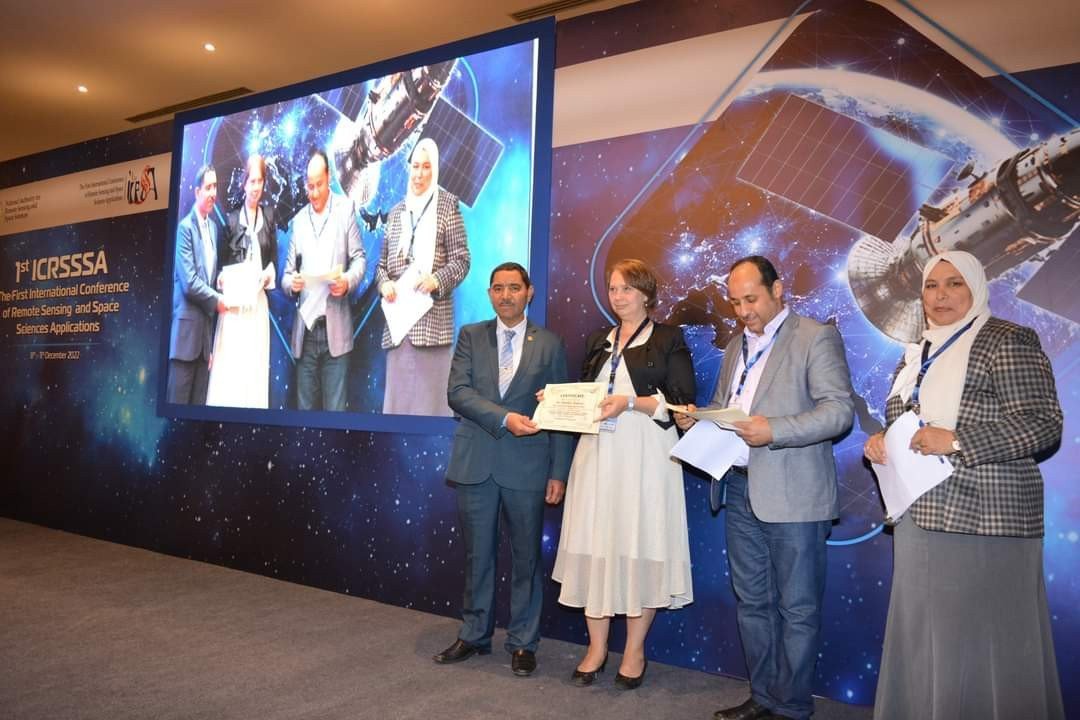About remote sensing of the earth — RUDN University ecologists at a conference in Egypt

At the conference, RUDN University was represented by two environmental scientists who presented reports on the geographical features of Afghanistan and increasing the yield of winter wheat using remote sensing technologies.
Daria Olegovna Kapralova, Ph.D., drew attention to the fact that adverse environmental conditions affect both the economic development of the region and the attitude of the population to environmental pollution. According to the geographical position, all countries are initially in an unequal position. Therefore, in order to achieve the Sustainable Development Goals, it is necessary to understand the impact of the average comfort of the country’s territory on all aspects of sustainable development: economic, social and environmental. The Associate Professor of the Department of Rational Environmental Management of RUDN University spoke about this in the report “The influence of geographical location on the sustainable development of the country on the example of Afghanistan”. The study examined 2,400 settlements in this country. The results showed that only 8 can be considered completely comfortable.
“Remote sensing is one of the fastest growing and most advanced scientific research tools in almost all existing fields of science and economic sectors, providing enormous opportunities, especially in the absence of other information about the territory”, Daria Kapralova, Ph.D., Associate Professor Department of Rational Environmental Management of RUDN University.
The conference was also attended by another scientist of the Institute of Ecology of RUDN University — Rebukh Nazih Yaser, Ph.D., Associate Professor of the Department of Environmental Management. The scientist presented a report
“Assessment of the impact of three cultivation technologies on the yield and quality of winter wheat grains using remote sensing in the Moscow region, Russia”, which was read out in a remote format.
“Remote sensing is an effective tool for crop management. In the future, the development of a mobile application for agricultural management using an UAV (unmanned aerial vehicle) is being considered together with colleagues from Egypt and Algeria,” Aliat Toufik, Associate Professor at Borj Bou Arrerij University.
The average yield of winter wheat in Russia is 3-4 t/ha. In 2021, in the Moscow region, the yield was 2.8 t/ha, which is far from the potential of this crop. Therefore, there is a need to improve the elements of cultivation technologies, taking into account varieties and soil and climatic conditions of the regions of the Central Non-Black Earth Region. RUDN scientists studied the response of new varieties of winter wheat to the levels of application of mineral fertilizers, plant protection products in cultivation technologies of different intensity levels and recommended 3 cultivation technologies: basic, intensive and high-intensity. With a low economic condition of the economy, all varieties can be cultivated using the basic technology.
Reference:
The First international conference for Remote sensing and Space Sciences Applications (ICRSSSA) was held on December 8-11, 2022 in Hurghada, Egypt.
The conference is an important event in the Middle East for the dissemination of the latest technologies, the exchange of expert opinions, the identification of future trends and the creation of an international platform for the exchange of innovative ideas that contribute to the development of remote sensing and space sciences at the global level. Since remote sensing and space sciences intersect with many other disciplines and sciences, the organization of the conference under this title provides an opportunity for researchers in various fields to discuss the challenges and problems facing the world.
About the organizer
National Authority for Remote Sensing & Space Sciences (NARSS), Cairo, Egypt
NARSS is a research institute with two major sectors for remote sensing and space science and technology applications. The Remote Sensing Applications sector is working to use data provided by Earth observation satellites and various airborne sensors to create maps and spatial data for various applications such as natural resource assessment and monitoring, natural disasters and environmental management. The space science and technology sector is engaged in research and development of sensors, satellite subsystems, etc.
Sergey Ivanov, a scientist from St. Petersburg, became the first winner of the RUDN University International Prize for scientific achievements and merits in the field of mathematics in the amount of 5 million rubles.
Egyptian scientist Abdelraouf Masoud Ali, associate professor at the Department of Environmental Management, Institute of Environmental Engineering, has been awarded the 2024 Egyptian State Incentive Prize in Agricultural Sciences.
Inventors from 26 countries and 35 regions of Russia presented more than 500 projects at the XVIII Moscow International Salon of Inventions and Innovative Technologies “Archimedes”. 340 projects belong to Russian participants, and their foreign colleagues — 215. RUDN University initiatives were awarded two gold medals.
Sergey Ivanov, a scientist from St. Petersburg, became the first winner of the RUDN University International Prize for scientific achievements and merits in the field of mathematics in the amount of 5 million rubles.
Egyptian scientist Abdelraouf Masoud Ali, associate professor at the Department of Environmental Management, Institute of Environmental Engineering, has been awarded the 2024 Egyptian State Incentive Prize in Agricultural Sciences.
Inventors from 26 countries and 35 regions of Russia presented more than 500 projects at the XVIII Moscow International Salon of Inventions and Innovative Technologies “Archimedes”. 340 projects belong to Russian participants, and their foreign colleagues — 215. RUDN University initiatives were awarded two gold medals.